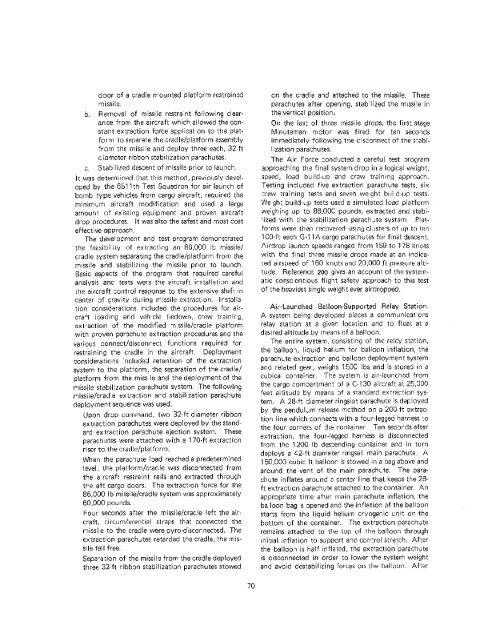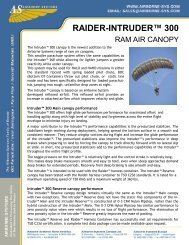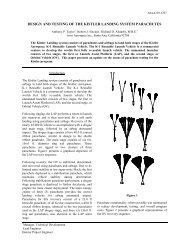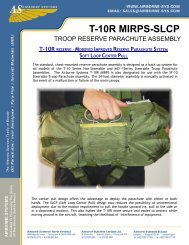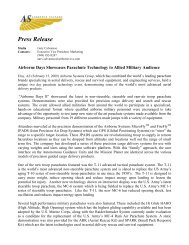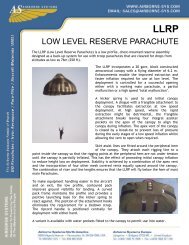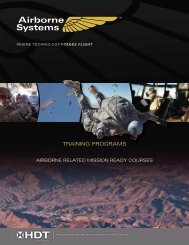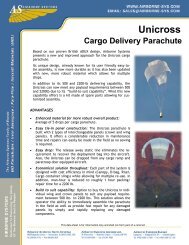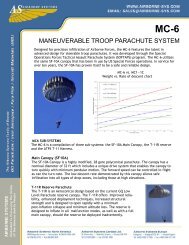"lfk f; \"A Lt. - Airborne Systems
"lfk f; \"A Lt. - Airborne Systems
"lfk f; \"A Lt. - Airborne Systems
You also want an ePaper? Increase the reach of your titles
YUMPU automatically turns print PDFs into web optimized ePapers that Google loves.
door of a cradle rrounted platf:rm reStrained<br />
missile.<br />
b. Removal of missile restrant following clearance<br />
from the aircraft which allowed the constant<br />
extraction force applicaton to the plat.<br />
form La separate the cradle/platfol m assembly<br />
from the missile and deploy three each, 32 ft<br />
c iometer ribbon stabi I i"ation pa-achutes.<br />
c. Stabilized descent of rris3ile prior to lau.lch.<br />
It was deierrninp.d lhat this methorJ , prs'liiously developed<br />
bv the 6511th Test Squadron for air launch of<br />
bomb type vehicles from cargo aircraft, required the<br />
minimum aircraft modification and used a large<br />
amount of existing equipment and proven aircraft<br />
drop procedures. It was also the safest and most cost<br />
effective approach.<br />
The development and test program demorstrated<br />
the fecsi bil i ty of ex I r flct'lng an' 86 000 Ib missi le/<br />
cradle system separatin;J the cradle/platform from the<br />
missile snd stabilizing the missile prior to launch.<br />
Basic aspects of the program that required careful<br />
analysis ane tests wer" the ",irt:raft irst"II;otiDn and<br />
Lhe aircraft::ontrol response to the extensive shift in<br />
center :Jf gravity during lTissile extraction. Irstolla<br />
tion considerations included the procedures for airera<br />
t load ing and vehcle tierJown , crew tra in i r'<br />
ext' action of the modified 11ssile/cradle platform<br />
with proven parachute extraction procedures and the<br />
various connect/disconr' ect functions required for<br />
restraining the cradle in the aircraft. Deployment<br />
considerations ' ncluded retention af the extracticn<br />
system to the platform , the sej:aration of the cradle/<br />
platform from the miss Ie and the deployment of the<br />
Missile stabilization parachute system. The following<br />
r1issi le/crad' e !:xtraction 81' d stabil ization parachute<br />
deployment sequence was used.<br />
Upon drup command, Lwo 32-ft diameter ribbon<br />
extraction parachutes were deployed by 'the stand.<br />
ard extraction parachute ejection system. These<br />
parachutes were attached with a 170-ft extraction<br />
riser to the cradle/platform.<br />
When the paraclutel::ad re"ched a predetermined<br />
IEYliel. the platform/cracife was discO'lnected hom<br />
the a:rcraft restraint rail3 and extracted through<br />
tre aft cargo doors. The extraction force for the<br />
000 Ib missile/cradle system was approximately<br />
000 pounds.<br />
Four seconds after the missile/cracle left the aircraft,<br />
circumferential straps that connected the<br />
f"issile to the cradle were pyro-discornected, The<br />
extraction parachutes retarded the cradle, the missile<br />
fell free.<br />
Sepa-ation of the missile from the crodle deployed<br />
three 32.ft ribbon stabilization parachutes stowed<br />
cn the cradle a1d attached to the missile. These<br />
parachutes after opening, stab Ii zed the missile in<br />
the vertical position.<br />
On the last of three missi Ie drops, the first stage<br />
Minuteman motor was fired for ten secolds<br />
immediately following tne cisconnect of the s:abi-<br />
I ization parachutes.<br />
The Air Force conducted 5 careful test :.rogrsm<br />
approaching the final system dmp in a logical weight,<br />
speed, load build-up and crew training approach.<br />
Testin;j included five extraction parachute tests . six<br />
::rew training te ts and seven we ght bui d-up tests.<br />
We gh: build- p tests used a simulated load platform<br />
wei(:hing up to 86 OOC pounds, extracted and stabi.<br />
lized with tile stabilization parach.Jte systel1 Platfo-ms<br />
wp,n then r" PCllVef2o using cI.Jste-s of up tD tell<br />
1CO-ft each G-l1A cargo parachutes for final ::escent.<br />
/\irdrop la\Jnch speeds rangedfrorn 159 to 178 knots<br />
with the final three missile drops made at an indicated<br />
airspeed of 160 knots and 20,000 fl pressur!: altitude.<br />
Reference 200 ';ives an account of the systematic<br />
cOllsccntious flig1t safety aj:proach to this test<br />
of the heaviest single weig lt ever airdropped.<br />
Air. Laurched Balloon-Supported Relay Station.<br />
A systef" being devalooed places a coml1unicafons<br />
relay station at a giver location and to float at a<br />
desired Clltitude by means of a balloon.<br />
The entire system, consisting of the relcy station<br />
the balloOl, liquid helium for balloon inflation . the<br />
pa-achL.te extractior and ballcon deployment system<br />
and related o!.ar , weighs 150C Ibs and is stored in a<br />
cubica. container. The system is air- 18unchcd tram<br />
the cargo com0artment ::f a C- 130 aircraft at 25,800<br />
feet altitud:: by mean" :Jf a standard EX trr.ction system.<br />
A 28-ft diameter rin';Jsiot parachute is der;loyed<br />
by the pendulJI1 release mcthod on a 200- ft extraction<br />
line which connects with a four-legged harness '<br />
the four corners of :he corrtainp.r Ten secDI cls after<br />
extraction, the lour-fegged harness is disconnected<br />
frOIT the 1200 Ib des:ending container and in turn<br />
deploys a 42-ft diameter ringsail main parachute<br />
150 000 cubic ft balloor is stowed in a bag above and<br />
around the \lent of the main parachL. te. The para-<br />
chute inflates aroLnd J ccntcr line that keeps the 28ft<br />
ex.traction parachute attached to the container. An<br />
appropriate time after rnain pariJchute inflation. the<br />
ba loon bags :Jpened and the inflation of the bafl::on<br />
starts from tho liquid helium cryogenic unit on the<br />
bottom of the container. The extraction parachute<br />
remains attached to the lop of the balloon through<br />
initial inflation to support ale, con rol stretch. .L\fter<br />
the balloon is half inflated, the extraction parachute<br />
is disconnected in order to lower the system weight<br />
and avoid destabilizing Torces on tll!: balloon. Ah8r


